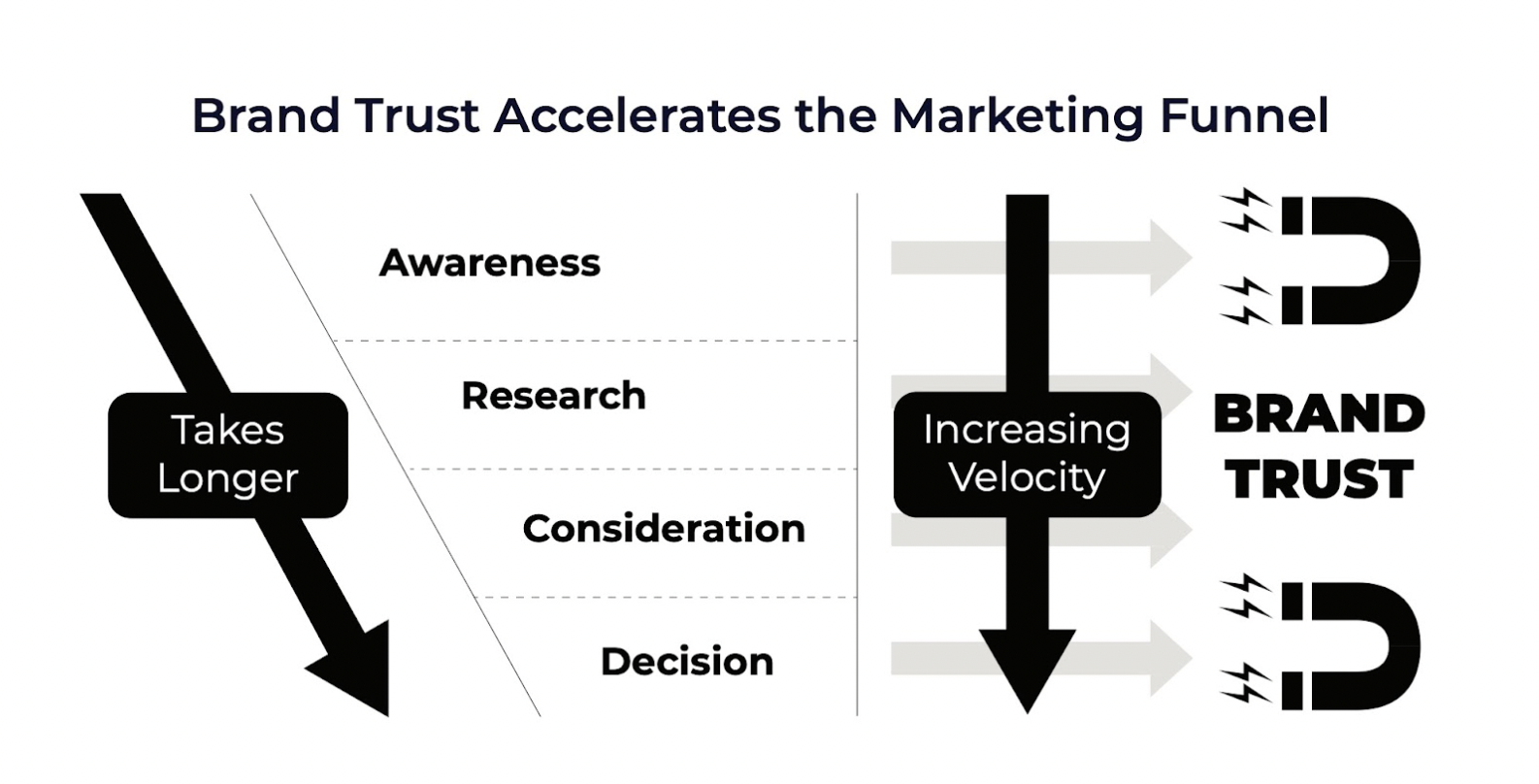Trust Seals Work—and Baymard Institute Has the Receipts to Prove It
Note: ActualInsights.com forwards to this post. Actual Insights was a Dutch research firm founded...

Everybody claims to be a growth hacker these days—at least if you check out people’s bios on LinkedIn.
The truth is that while marketers, developers, and product managers can team up on some clever customer acquisition strategies to build user bases fast, most things that last take time.
Trust, for example.
You can’t build it overnight because until you have some skins on the wall, and until you have proven you are good at what you do, people will be wary. That’s just human nature.
One of the things I find most frustrating as a marketer is when companies do put in the time and effort to make customers happy— but then don’t take the necessary steps to use that accumulated trust to fuel customer acquisition.
It’s amazing how many brands have achieved high customer satisfaction levels, industry endorsements, and other trust signals, but simply don’t realize the value of sharing this information. Or they understand the value, but they don’t know how to effectively share trust signals on their website and in other marketing channels.
You don’t need growth hacking in these cases. You simply need to put trust signals to work for your business.
THE INFLUENCE OF WEBSITE TRUST SIGNALS ON ECOMMERCE SALES
Because trust signals emerged from the world of ecommerce, it shouldn’t be surprising that most published research has focused on their impact on conversions and sales. And there is a significant accumulation of data to show that trust signals work.
The Baymard Institute, a user-experience research house based in Denmark, has conducted more than 88,000 hours of studies, tests, and experiments to identify best practices for ecommerce website design. The research covers many of the trust signals we discussed in Chapter 5, including the impact of quality content, intuitive navigation, case studies, first-party reviews, expert endorsements, trust seals, and more.
Following is a sample of what Baymard has learned in its research (Baymard Institute, n.d.).
Quality Content
Baymard found that nearly a third of shoppers consider better product information the most important reason to shop online compared to physical stores, where consumers are often limited to information on product packaging or what a store employee can tell them. Baymard found that online shoppers sought product descriptions that:
When not provided with enough detail, shoppers figured a product didn’t have the features they needed—so they left.
If the copy did have enough detail but wasn’t organized to be easy to read, the shoppers felt overwhelmed—so they left.
If the copy had sufficient detail and was well-organized, but was too salesy, shoppers felt distrustful—so they left.
Users routinely told Baymard’s researchers before abandoning a site that they would “go to Google” to get their questions answered. Many of those users never came back.
Intuitive Navigation
Navigation is important for all websites, but for ecommerce websites offering a wide range of products, mistakes can make the difference between success and failure.
In user studies covering thousands of home page and category navigation elements, Baymard found that subpar user experiences were frustratingly common. The research house reported, for example, that the majority of ecommerce websites required their visitors to use the exact same language the site used when searching for products.
For example, a visitor to an online retailer might search for a blow dryer but not find it if the site used the term “hair dryer” in its taxonomy. That can lead to both the loss of a sale and the assumption that the store doesn’t carry the product—causing long-term brand damage.
Ecommerce stores with intuitive navigation, by contrast, increased their sales while burnishing their brands.
Customer Reviews
First-party reviews are customer reviews that a company collects on its own website to share with visitors. Baymard said the importance of these reviews for online shoppers is difficult to overstate—with up to 95 percent of test subjects relying on reviews in their buying decisions.
However, first-party reviews were generally greeted with more skepticism than reviews on Google or other third-party platforms. If a user only found five-star reviews on a brand’s website, they were more likely to assume the reviews were manipulated and discount their value.
Baymard found that 53 percent of users specifically sought out bad reviews. Brands that included negative reviews on their site—even allowing users to search for them by star rating—were more trusted by users. Brands also earned trust by responding empathetically, rather than defensively, to negative reviews.
![]()
SIDEBAR: TRUST SEALS: TRANSLATING TRUST INTO CONVERSIONS
A trust seal provides valuable third-party validation for those websites that use it. But how can this value be measured, and how does it translate into conversions and sales?
TrustedSite, a San Francisco-based web security company and issuer of trust seals, has a longstanding blog series called “Testing Trust,” in which digital marketing agencies put its trustmarks to the test for their clients and share their findings (TrustedSite, n.d.).
Some of the results:
Major retail brands don’t have the same need for trust seals as smaller ecommerce stores. Brands that are household names generally don’t bother displaying the Norton or Better Business Bureau seals on their sites, for example. These brands have established enough trust over time that visitors already believe their businesses are credible and assume their websites are secure.
However, the Baymard Institute notes in its research that design bugs are a frequent cause for cart abandonment for even the largest brands—Amazon, Walmart, and Apple.
The research house gave the example of a flaw in the Micro- soft Store’s credit-card form that caused placeholder text in the postal code field to be superimposed by the user’s auto-fill text. The mistake made the field unreadable. Confused shoppers feared the form did not function properly or had been hacked— so they left.
This example shows that website trust signals, such as professional design and attention to detail, aren’t just for smaller brands. Even the biggest brands can lose business through design oversights and other errors that reduce buyer trust.
![]()
FROM SHORT-TERM SALES TO LONG-TERM GROWTH
Trust signals clearly help online brands—from apparel retailers to SaaS vendors—to sell more product. But this only scratches the surface of their potential impact over time.
By approaching trust signals more broadly, any business can develop a strategy that improves more than checkout-page conversions. The more far-reaching and enduring benefit of a trust signals strategy is to build, grow, and protect your brand.
I saw a business cartoon recently that made me laugh, then grimace. It showed two men standing in side-by-side kiosks with signs advertising their competing services. One vendor’s sign said, “LOW-QUALITY LEADS.” The other read, “BRAND BUILDING.” The punchline was that the line for buying bad leads was a mile long. Not a soul was in line to build their brand.
It’s a common story, particularly for midsize and smaller companies that believe they simply can’t afford the luxury of brand marketing if they want to grow. Unfortunately, this approach often results in businesses that find themselves on a hamster wheel, constantly chasing short-term sales rather than investing in long-term growth.
LEAD GENERATION VERSUS TRUST GENERATION
Brand building is not lead generation. It’s trust generation. It makes your leads better and your funnel stronger. It can help you avoid commoditization and demand a higher price. It can make the difference in attracting and retaining top talent as well.
I’ve worked with many CMOs whose narrow focus on MQLs and SQLs (marketing- and sales-qualified leads, respectively) has mostly led to LQLs—low-quality leads. Those are the leads that are often a source of friction and finger-pointing between marketing and sales.
Even in the best of circumstances, leads that don’t convert are not uncommon. The average MQL—a lead that has shown some level of interest in your product—only becomes an SQL—an actual sales prospect—about 10–15 percent of the time, on average, for most medium- and high-consideration purchases. That’s true whether these purchases are B2B or B2C.
But the conversion rate varies greatly based on the quality of the MQL. And while businesses may look at any number of reasons for leads being of low quality—especially from sources like email campaigns and trade shows—the biggest reason is that companies haven’t built sufficient brand equity to win their buyers’ trust.
The illustration below shows the influence of brand trust on the sales and marketing funnel, adapted from a concept developed by Branding Strategy Insider. There are four stages from product awareness to the buying decision—with brand trust, once established, reducing friction all along the journey. 
This is how a forward-looking PR firm should view its role in helping companies grow. Don’t settle for the limited role of the traditional PR firm, but don’t be coaxed by prospects into a short-term, lead-generation focus. Instead, go deeper to help your clients better understand their customers, build awareness, and develop relationships of trust across every marketing touchpoint.
While the value of brand trust can be difficult to measure, one approximation comes in the form of the goodwill line of a business’s balance sheet. When one company acquires another for a price higher than net fair value, the difference is called “goodwill.” The acquired company’s brand equity is one of the key components of goodwill.
Today, more than half of the corporations in the S&P 500 have goodwill balances of more than $10 billion from their acquisitions.
That’s a lot of money paid for brand trust.
AVOIDING THE COFFEE-SPOON APPROACH TO BRAND MEASUREMENT
When T.S. Eliot’s J. Alfred Prufrock famously laments that he has “measured out my life with coffee spoons,” he is expressing regret for all the opportunities he has lost by leading a safe, predictable life.
So it often goes with brand-building programs. Scrutinizing short-term costs too closely can come at the expense of long-term ambitions. Put another way, if you measure your ROI in coffee spoons, you may end up bemoaning lost opportunities just as Prufrock did.
For this reason, some businesses choose not to measure their investment in brand awareness and growth at all.
In 2021, Lessonly, a successful sales-training platform, was acquired by Seismic, a three-billion-dollar sales-enablement technology company. In celebrating the acquisition on LinkedIn and Twitter, Lessonly CMO Kyle Lacy (2021) shared that one of the keys to the company’s growth and success was its decision to “cease all measurement of branding efforts.”
Lacy went on to explain that the company decided to split its marketing spend into two parts: demand and brand. While the demand-generation budget was closely measured for ROI, the brand-building spend—representing up to 30 percent of the total marketing budget—wasn’t measured at all.
As a result of this decision, Lacy said, “our brand story grew stronger and made a larger impact because it wasn’t being constantly scrutinized for spend.” The team was able to focus entirely on improving brand awareness and trust rather than constantly worrying about ROI.
Over time, he concluded, this led to greater ambitions, higher returns, and superior growth.
MEASURING THE IMPACT OF TRUST SIGNALS ON BRAND GROWTH
While it’s not necessary to go to the lengths of Lessonly, it is crucial not to attempt to tie branding programs directly to sales on a day-to-day basis. That dooms your efforts to failure.
But there are metrics to help you see if you’re on the right track in building awareness and trust for your brand through trust signals.
These include:
Let’s take a closer look at each of these metrics.
Direct and Branded Search Traffic
Direct traffic is when someone enters your URL directly into a browser’s address bar or clicks on a bookmarked link. Branded search traffic is traffic that results from a Google search for your brand name or brand-plus-keyword combination. A steady increase in direct traffic, branded search traffic, or both is a clear sign that your brand marketing efforts are working.
For one of Idea Grove’s clients, an international provider of back-office automation solutions, our team increased media coverage by more than 700 percent in the first year of the engagement. This led directly to a 180 percent increase in direct and branded search traffic to the client’s website, a clear indicator that our brand awareness efforts were working.
Media Visibility and Share of Voice
PR agencies have long measured the volume, quality, and tone of media coverage to track increases in media visibility and positive media coverage. Since the 1940s, agencies have used a metric called Ad Value Equivalency (AVE) to estimate what a media placement would have cost had it been a paid ad, based on a publication’s going advertising rates.
Today, PR software vendors like Meltwater offer a modern take on AVE by partnering with website traffic analytics partners like Similarweb. Other measurement companies, like CoverageBook, take a different approach to measuring media visibility—aggregating and reporting on online readership, domain authority, coverage views, links from coverage, and social shares.
If your business has specific industry rivals in its sights, improvements in your brand’s Share of Voice (SOV) can be a valuable measure of progress in gaining market awareness and trust. Monitoring tools like Cision and Meltwater can help you track your brand’s visibility in the news media and social media relative to competitors.
Search and Social Media Presence
How can you tell if you are building brand trust through your search and social media presence? For me, it was when the phone started ringing.
Shortly after I started Idea Grove as a one-man agency in 2005 I began writing a blog—mostly because I had no clients and nothing better to do with my time! I wrote about whatever came to mind— PR, marketing, technology, movies, celebrity gossip. Anything to keep me, and eventually my audience, amused.
I didn’t know much about SEO at the time, but within a few months of starting the blog, I began receiving calls from companies who wanted to work with me. As it turns out, I was one of only a handful of PR practitioners in Texas who were blogging at the time, and Google rewarded me by ranking my agency at the top of search results for terms like “Dallas PR firms”—over giant firms with Dallas offices like Edelman and FleishmanHillard. And the business flowed in.
More than a decade and a half later, it’s not as easy as it used to be, because there’s a lot more competition. But it still works the same way, and it’s still worth it. Increasing your organic search volume, social media engagement, and social media referral traffic is a sure sign you are growing your audience and building trust.
Buyer Surveys and Market Research
Many companies I’ve worked with—even large ones with sizable marketing budgets—seem to be allergic to conducting market and customer surveys. The cost and time involved scares them off.
That’s unfortunate, because this research, done well, is the most precise way to measure your success in building brand awareness. Unlike other sources of measurement, surveys don’t require you to make assumptions based on website traffic or other data. There’s simply no better way to determine if your brand messaging is hitting its mark or falling on deaf ears than by asking the people you’re trying to reach.
Effective research doesn’t have to break the bank. You could have questionnaires on your website, asking how visitors discovered you or if they have heard of you before. You could ask your current customers when and how they learned about your brand. You could field surveys of target audiences to see whether they know your brand, and if they do, what they think of it. Do the research in regular intervals, with the same targets, and you’ll get a very clear indication of whether your brand-building efforts are working.
BRAND LIFT FOR THE LONG HAUL
Compared to lead-generation programs, it can be very difficult to trace business results directly to specific brand-building efforts. If someone comes across your company’s name in a news article, for example, it might result in a branded search weeks later.
Over time, however, if you don’t begin to see significant lift in these metrics, it could be a sign that your brand’s message isn’t resonating or that your product isn’t capturing the public’s interest. It could also be a sign that your trust signals strategy is missing the mark.
Growth hackers pride themselves on launching clever promotions to grow customer bases fast. But for most brands, a strategy focused on establishing trust—sending the right trust signals to the right audiences at the right time—will deliver better long-term results.
In our post-truth world, figuring out what’s “right” for our audiences can be challenging, of course—but it’s attainable. We’ll tackle that in the next chapter.

Scott is founder and CEO of Idea Grove, one of the most forward-looking public relations agencies in the United States. Idea Grove focuses on helping technology companies reach media and buyers, with clients ranging from venture-backed startups to Fortune 100 companies.

Note: ActualInsights.com forwards to this post. Actual Insights was a Dutch research firm founded...

Every business wants to be trusted—but some are better at gaining trust than others.
It helps, of...
Leave a Comment